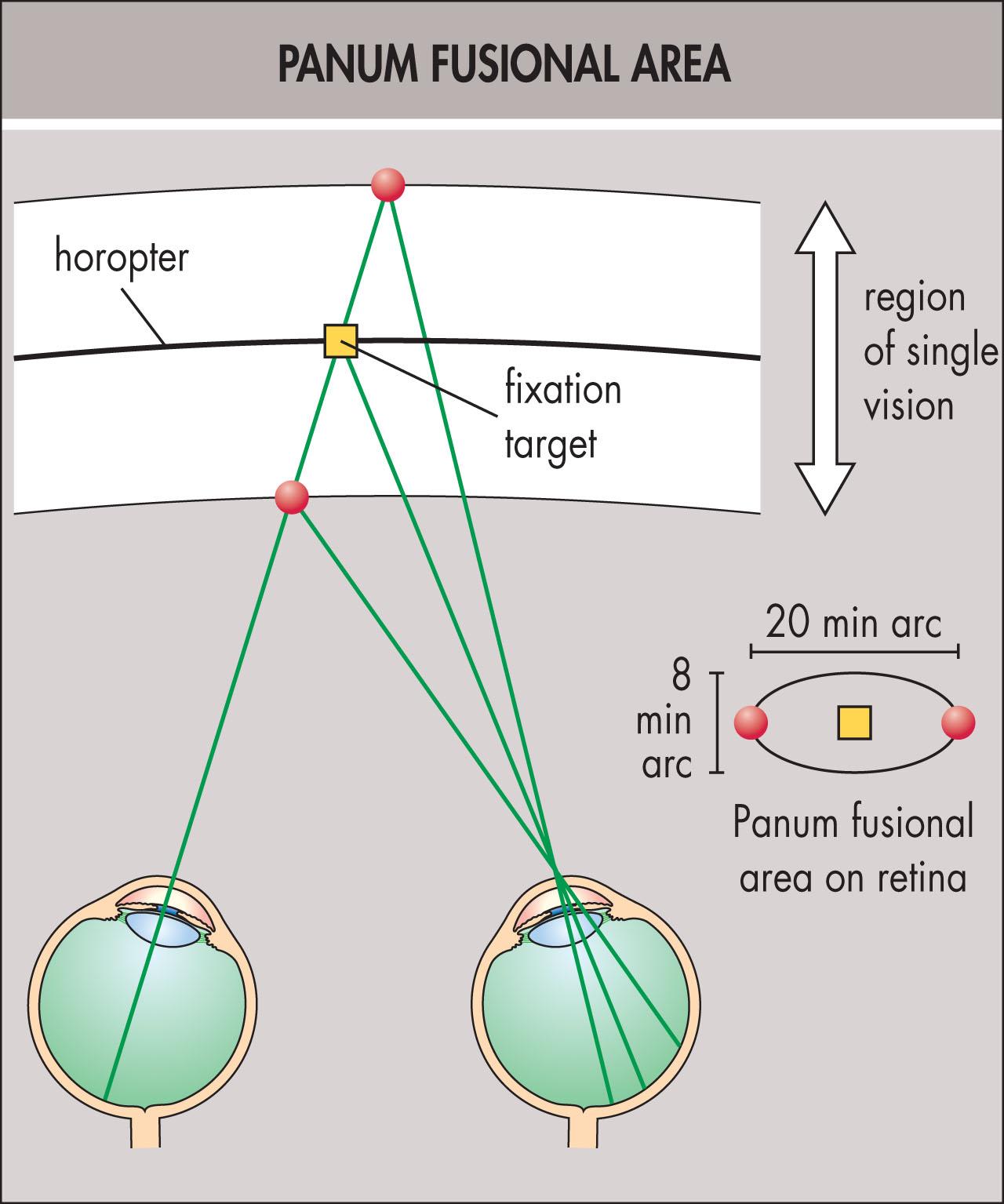Physical Address
304 North Cardinal St.
Dorchester Center, MA 02124
Sensory fusion: cortical integration of similar images into a unified percept.
Horopter: the locus in space representing the intersection of all object locations that project images onto corresponding retinal points.
Panum's fusional area: area in space surrounding the horopter in which objects are perceived as single, although their images fall on noncorresponding retinal points.
Motor fusion: vergence eye movements stimulated by subconscious detection of retinal image location disparity, designed to restore and maintain single binocular vision.
Stereopsis: a form of depth perception achieved through cortical detection and processing of normal horizontal image disparity generated by objects located off of the horopter.
Critical period : a period early in life characterized by robust cortical neuroplasticity to visual input.
Subjective tests for binocular vision are essential in patients with strabismus or binocular vision dysfunction.
Three different types of binocular vision can be clinically evaluated: sensory fusion, motor fusion, and stereopsis.
Three types of binocular vision can be evaluated in the clinic: sensory fusion, motor fusion, and stereopsis. Each of these is based on the ability of the visual cortex to detect two separate but similar inputs, determine the eye of origin for each, identify the point in space from which the content originated, and distinguish between matching and nonmatching inputs. Patients with normal binocular vision who develop strabismus for the first time after the critical period will experience diplopia, visual confusion, and loss of stereopsis until alignment is restored. Binocular patients with onset of strabismus during the critical period develop cortical sensory adaptations, such as suppression and anomalous retinal correspondence (ARC), that restore a crude form of single binocular vision (see Chapter 11.5 ).
Clinical testing of sensory status in patients with strabismus is important, even if the patient is asymptomatic. Similarly, testing of sensory status in symptomatic patients without obvious strabismus can reveal anomalies in binocular vision. Test selection and interpretation of test results are easier if the basic physiology of binocular vision is understood.
In the study of binocular vision, it is convenient to think of the cortical input as arising from stimulation of “retinal elements.” Retinal elements refer to the whole retinocerebral apparatus corresponding to a specific area of retinal surface. The fovea innately carries the principal visual direction (straight ahead of the viewer) and a retinomotor value of zero. All other retinal elements carry visual directions equivalent to their distance from the fovea. These retinomotor values guide eye movements and facilitate fusion.
Frontally placed eyes result in extensively overlapping monocular visual fields. Without a cortical mechanism to reconcile the inputs from the two eyes, fusion would be impossible. Fortunately the visual cortex is designed to identify matching and nonmatching inputs and process them in a way that creates a visual experience greater than the sum of the inputs. All elements within the common visual field area have a corresponding element in the fellow eye that shares the same visual direction. Inputs from corresponding elements are coupled in the visual cortex, and if the inputs are similar, single binocular vision results. Uncomfortable binocular vision, such as diplopia and visual confusion, occurs when similar images project onto noncorresponding elements or dissimilar images project onto corresponding elements.
Sensory fusion is the cortical integration of similar images that project onto corresponding retinal elements, or onto elements with a very small location disparity error. The locus representing the intersection of points in space that stimulate corresponding retinal points at a specified fixation distance is called the horopter . Such images have a disparity value of zero. Objects located on the horopter project their images onto corresponding retinal elements, resulting in fusion. The horopter is defined by the fixation point and forms an arc curving toward the subject ( Fig. 11.4.1 ).

A vertical horopter also exists: the locus of points in space where objects produce images with zero vertical disparity on the retina. The vertical horopter is a straight line tilted away from the observer, passing through the fixation point.
Sensory fusion still may occur if the object is located just off of the horizontal empirical horopter in the sagittal plane such that a minor horizontal disparity error is created. This zone is known as Panum’s fusional space (see Fig. 11.4.1 ). Panum’s area forms an ellipse that is wider than it is tall, narrowest at the fovea, and increasing toward the periphery due to the effects of retinal eccentricity. The ultimate size and shape depend on a number of factors, including fixation distance and the individual’s latent vergence error. No similar fusion space surrounds the vertical horopter.
Objects in front of or behind Panum's fusional space stimulate noncorresponding retinal areas with disparity errors too great to allow for sensory fusion, but may still inform motor fusion and stereopsis. Objects farther away from Panum’s fusional space create binasal image disparity; objects closer create bitemporal image disparity. This creates uncrossed and crossed physiological diplopia, respectively. Physiological diplopia is rarely noticed by the observer under natural viewing conditions.
The disparity information generated by stimulation of noncorresponding retinal areas outside Panum’s area is processed and put to good use. One of the ways disparity information is exploited is the generation of motor fusion. Motor fusion (fusional vergence, disparity-driven vergence) is vergence stimulated by the subconscious detection of image disparity that restores and maintains sensory fusion. Motor fusion is used to acquire a single image of the target of interest and also is responsible for maintaining orthotropia in spite of small eye alignment errors (phorias).
Become a Clinical Tree membership for Full access and enjoy Unlimited articles
If you are a member. Log in here